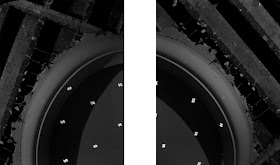 Export 2008
Export 2008The text, in Italian is taken from galleria monotono website.
Erased Palladio
Inaugurazione sabato 22 novembre ore 18.30.
La mostra sarà visitabile dalle ore 16.00 alle ore 22.00.
Orari di apertura: lunedì - venerdì, 09.00 > 18.00, sabato e domenica su appuntamento.
Con la mostra Erased Palladio (“Palladio raso al suolo”, “Palladio cancellato”) Italo Zuffi inaugura la stagione espositiva di Monotono. Nell’anno in cui si celebra il V centenario della nascita di Andrea Palladio, l’artista si sofferma sul concetto di “esportabilità” di uno stile e delle sue successive alterazioni alla ricerca di una perenne adattabilità, sfiorando appena il racconto di un’architettura intesa come luogo di proiezione di un potere o della sua evoluzione in anfratto confortevole e multifunzionale.
Artista versatile e da sempre interessato a frequentare diversi linguaggi (dalla scultura, al video, alla fotografia, alla performance), Zuffi si avvicina all’opera del Palladio nel 1999 attraverso alcune ricognizioni nei siti delle ville dell’architetto, in seguito alle quali realizzerà la prima serie dei “Profilati”, grandi oggetti geometrici, in legno dipinto, ispirati appunto alle piante di edifici palladiani.
Con il progetto Erased Palladio, Zuffi vuole dar vita ad una mostra frutto di diverse ricerche e suggestioni, non ultima la verifica di quell’azione palladiana di “domesticamento” nei confronti del linguaggio architettonico classico. Obiettivo primario dell’artista sarà inoltre quello di rendere concreta una riflessione su alcune ipotesi legate alla fruizione dell’architettura, da lui essenzialmente “percepita e rappresentata come rifugio e come speranza da cui proiettarsi verso l’esterno, stazione temporanea, sito di partenza e di ritorno per continue razzie nello spazio aperto”; nonché luogo di “ostentazione di trofei raccolti nel corso dei vari tentativi di fare esperienza del mondo”.
Il nucleo principale della mostra, che si sviluppa su una superficie espositiva distribuita su tre livelli, è costituito da un’inedita serie di opere, in parte realizzate grazie alla collaborazione di maestranze ed artigiani locali. Tra queste sono da segnalare: la riproduzione in scala 1:1 della base di una colonna palladiana (da Villa Sarego, nel veronese), a cui è stata applicata un’alterazione; un’opera scultorea a parete, realizzata in metallo palladio; e, ancora, una nuova versione dell’opera “Manager a passeggio”, nata dalla mappatura di superfici architettoniche di alcuni edifici vicentini. In parallelo, l’artista espone alcuni lavori che, elaborati nel corso della ricerca svolta negli anni precedenti e incentrati su temi architettonici, vengono riproposti nel dialogo con le opere più recenti e riletti in un nuovo contesto espositivo.
I partner tecnici che hanno reso possibile la realizzazione della mostra sono:Gioielleria Soprana, Grassi Pietre Srl, Lanifico Bonotto, Oreficeria Salin.


























.jpg)





















